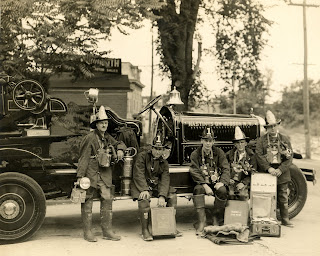 Back in the mid-50s, when I was in elementary school, the annual Easter Egg Hunt in town was a very big deal. This was the time when TV shows were in shades of black and white, and the Saturday morning line-up was the Modern Farmer followed by an endless stream of old-time cartoons. So a Saturday morning event for all the children of Hastings to enjoy was a welcome treat.
Back in the mid-50s, when I was in elementary school, the annual Easter Egg Hunt in town was a very big deal. This was the time when TV shows were in shades of black and white, and the Saturday morning line-up was the Modern Farmer followed by an endless stream of old-time cartoons. So a Saturday morning event for all the children of Hastings to enjoy was a welcome treat.As I remember it, everyone would meet in the village, either at the VFW or old Youth Center and parade up Main Street toward five corners. When we arrived at that junction, we either headed straight toward Reynolds Field or took the right toward Draper Park. Each year the location was a closely guarded secret so that nobody could get an advance look at where the eggs were hidden.
Because we were part of the baby boom generation, we were a sizeable group moving towards our destination; no doubt we halted all traffic. Having felt the crush of the crowd, I think some years our numbers might have reached 60 - 70. Just prior to starting, all the children were categorized by age or grade. This gave everyone an equal chance at discovering an egg. And each age group had a different hunting area, with the more challenging areas and well-hidden eggs reserved for the older children. Parents weren’t allowed to participate, other than to watch the mayhem unfold as excited kids darted here and there looking for the eggs.
The eggs we hunted were made of wood and were painted various colors. I remember a silver egg and a golden egg, but I don’t recall if these had any more importance than the others did. The one and only year that I scooped up my egg, it was painted silver. When I turned it in, I was given a fabulous, cellophane wrapped, wicker basket full of sweets. Every Easter basket had one large chocolate bunny inside plus little chocolate eggs and bunnies, marshmallow chicks, and jellybeans of assorted color. Even if you didn’t find a wooden egg, no child left empty handed. Everyone was given a generous, half-pound size tub of jellybeans. It was great event. I think the South Side Club sponsored it, but I’m not certain.
Oh, I forgot the bunny. Every year the Easter bunny would appear at this event. I remember Margie McCarthy being the bunny when I was little. But since I’m the oldest of five children, I often went to the parade as the babysitter for my brothers and sisters. By the time I stopped parading some time in the 60s, the bunny was Cathy Zahurak.
Judy (Wemer) Chamberlain


































